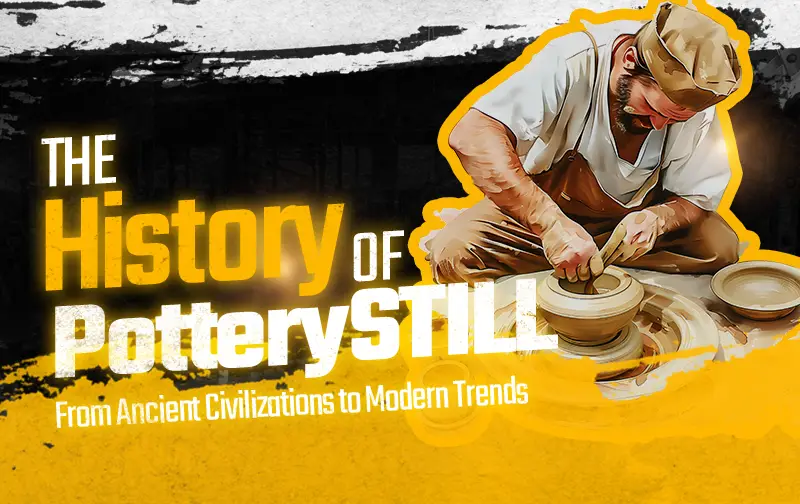LET'S REVIVE YOUR WALL
- Home
- Blog Detail

The History of Pottery: From Ancient Civilizations to Modern Trends
- September 24, 2024,
One of the world’s oldest and enduring forms of art and creative expression is pottery art. From the simple, utilitarian vessels of ancient civilizations to the intricate designs of contemporary artisans, pottery has evolved significantly throughout history. In this blog post, we’ll explore the fascinating journey of pottery art, highlighting its significance in various cultures and how modern trends are shaping its future.
Ancient Pottery Art: A Window into Civilization
Pottery has been around for thousands of years, with some of the earliest known examples dating back to around 29,000 BCE. The use of clay for creating vessels and figurines marked a significant advancement in human creativity and functionality. Early ancient pottery art served essential purposes, such as storing food and water, cooking, and religious ceremonies.
The Earliest Evidence
The oldest known pottery was discovered in what is now Ukraine, where clay figurines and vessels were crafted using primitive techniques. As civilizations developed, so did pottery techniques. The Neolithic period saw the emergence of fired pottery, which provided greater durability. The pottery art of cultures like the Chinese, Egyptians, and Mesopotamians showcases their technological advancements and artistic expression.
Cultural Significance
In ancient Egypt, pottery didn't just serve as practical items but also as decorative art pieces, often featuring intricate designs and hieroglyphics. Similarly, the Greeks introduced painted pottery, which depicted scenes from mythology and everyday life. The art pottery for sale in ancient marketplaces would often tell stories and reflect societal values, acting as a crucial cultural artifact for historians today.
The Evolution of Pottery Techniques
As civilizations progressed, so did pottery techniques. The invention of the potter's wheel around 3500 BCE revolutionized pottery art, allowing for more symmetrical and finely crafted pieces. Different regions developed their unique styles and glazes, leading to a rich diversity in pottery forms.
Asian Influences
In Asia, particularly in China, the invention of high-fired stoneware and porcelain set a new standard for durability and beauty. Chinese artisans mastered techniques that would influence pottery practices worldwide. The exquisite craftsmanship of Chinese pottery remains highly sought after, with many collectors seeking handmade ceramic pottery that embodies traditional techniques and modern aesthetics.
European Renaissance
The European Renaissance marked another pivotal moment for pottery art. During this period, there was a revival of classical techniques, and new materials and styles were introduced. Pottery artisans began to explore colorful glazes and intricate patterns, leading to distinctive styles such as Delftware in the Netherlands and Majolica in Italy. The flourishing trade routes allowed for cultural exchanges that enriched pottery art across the continent.
Modern Trends in Pottery Art
In today’s world, pottery blends well with ancient traditions and contemporary techniques and ideas, making it thrive continuously. The modern pottery movement is characterized by a focus on sustainability, creativity, and personal expression.
Handmade Ceramic Pottery
The revival in interest in handmade ceramic pottery highlights a broader trend toward artisanal and locally produced goods. Many contemporary potters prioritize sustainability, using natural materials and environmentally friendly practices. The tactile nature of handmade pottery resonates with consumers who appreciate the uniqueness of each piece. Artisans often draw inspiration from ancient techniques, infusing their work with a sense of history while making it relevant to today’s audience.
Pottery Art Ideas
For those looking to explore their creativity, there are endless pottery art ideas to try. From sculptural forms to functional dinnerware, the possibilities are vast. Workshops and classes are increasingly popular, providing opportunities for individuals to learn from skilled artisans. Many local suppliers, like Armaan National Supplies, offer materials and tools for aspiring potters, ensuring that the art form continues to flourish.
The Global Pottery Community
In recent years, the global pottery community has grown, thanks in part to social media platforms that allow artists to share their work and techniques with a broader audience. Online marketplaces enable artisans to sell their creations directly to consumers, bypassing traditional retail channels. This shift has opened up new avenues for artists, allowing them to showcase their unique styles and connect with enthusiasts worldwide.
Art Pottery for Sale
The demand for unique and artistic pottery has led to a vibrant market for art pottery for sale. Collectors and enthusiasts seek out pieces that not only serve functional purposes but also embody the artist's vision and creativity. This trend has resulted in the growth of pottery fairs, exhibitions, and online galleries that celebrate the diversity of styles and techniques across cultures.
Conclusion
The history of pottery art is a testament to human creativity and cultural evolution. From its origins in ancient civilizations to its place in modern artistic expression, pottery continues to be a vital form of art that resonates with people around the world. As we look to the future, the blending of traditional techniques with contemporary ideas will undoubtedly keep the art of pottery vibrant and relevant. By embracing the past while innovating for the future, pottery art will continue to inspire generations to come. So grab some clay, find inspiration in the rich history, and start your pottery journey today, or grab a beautiful piece for yourself at Armaan National Supplies!

